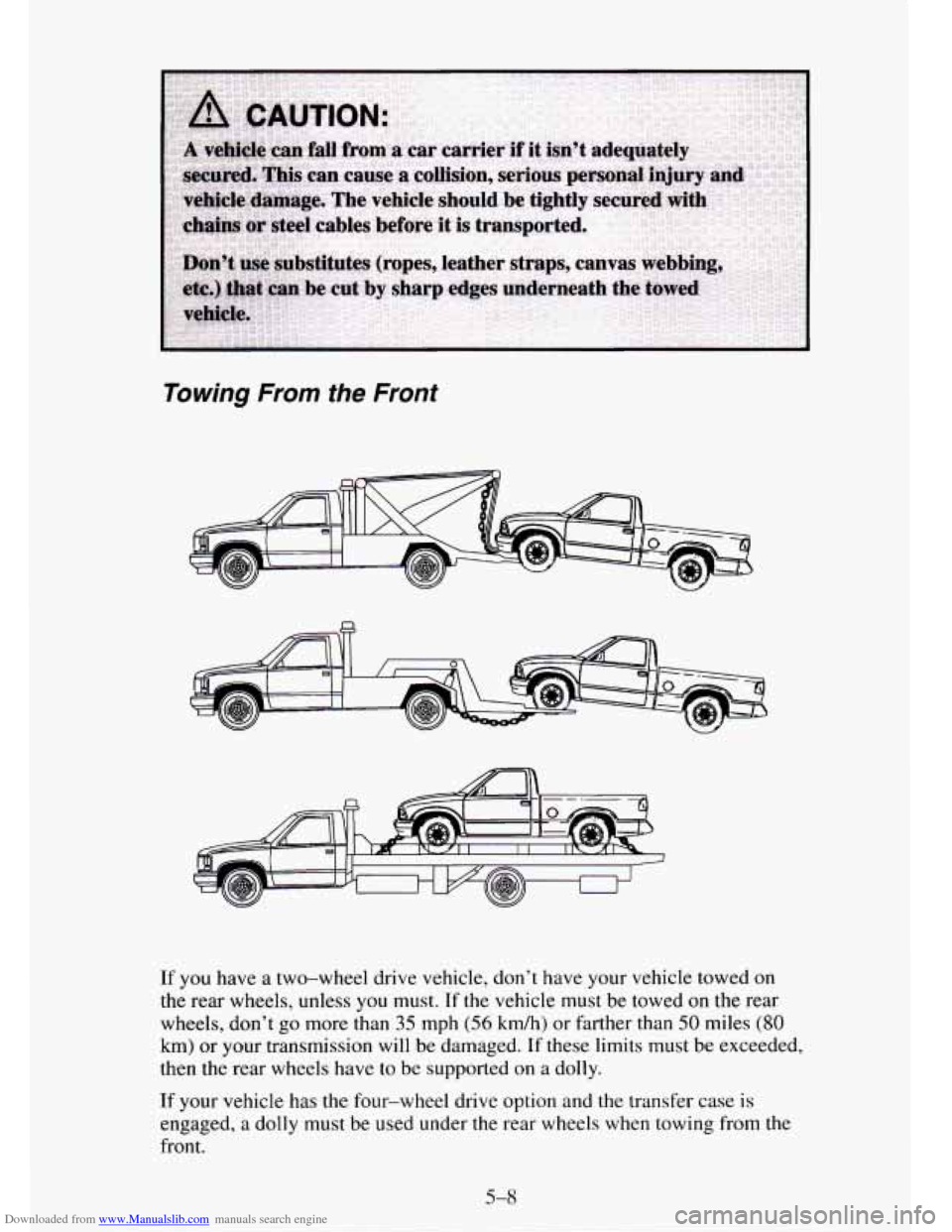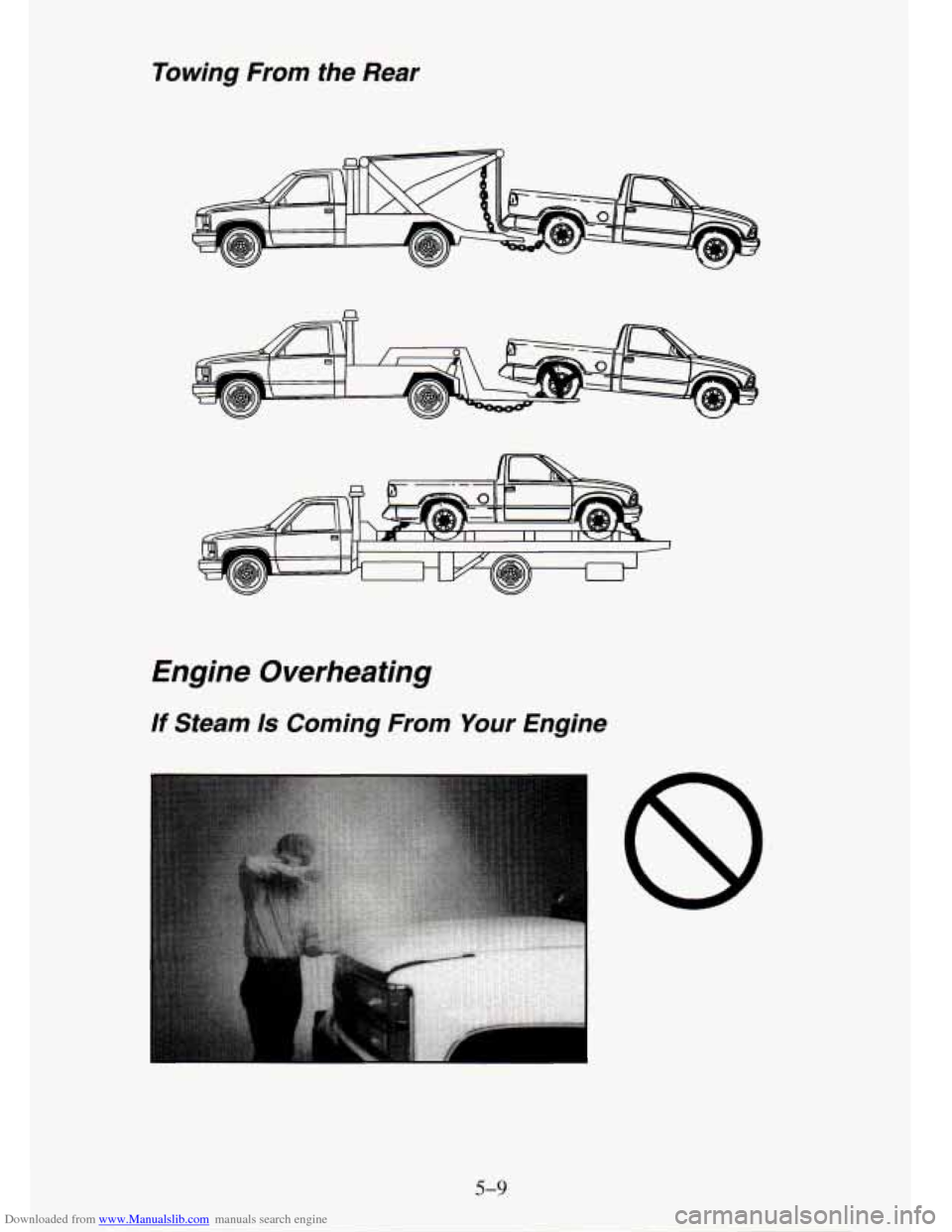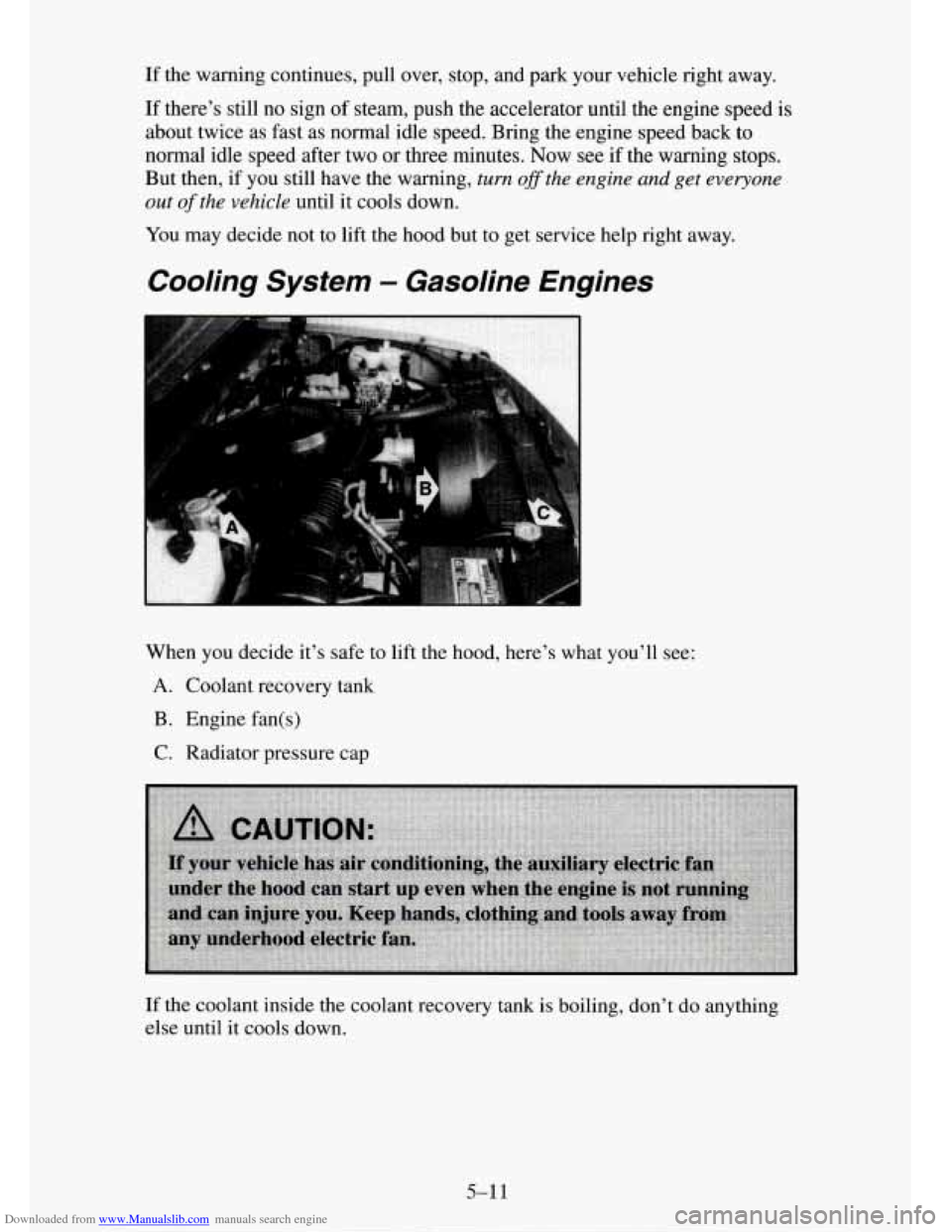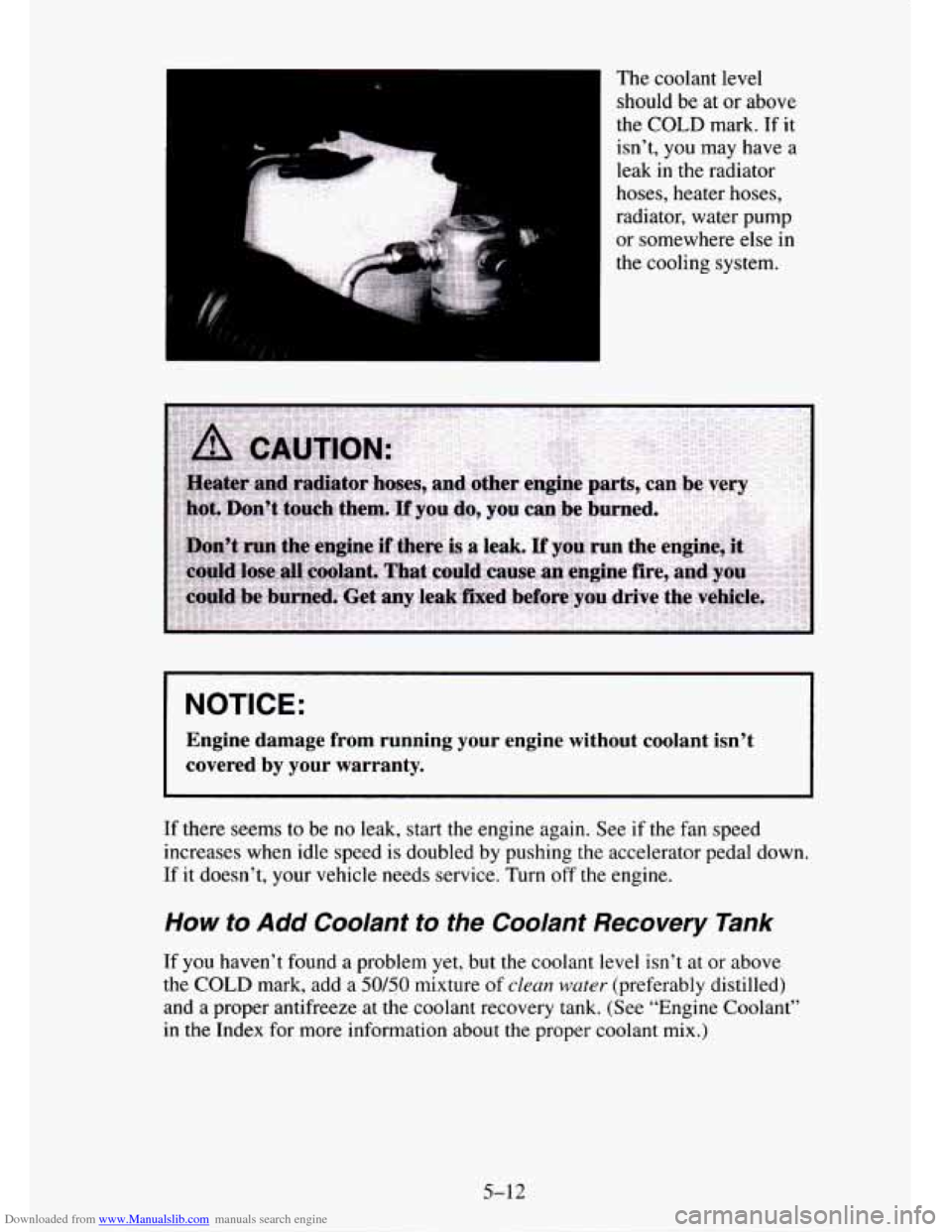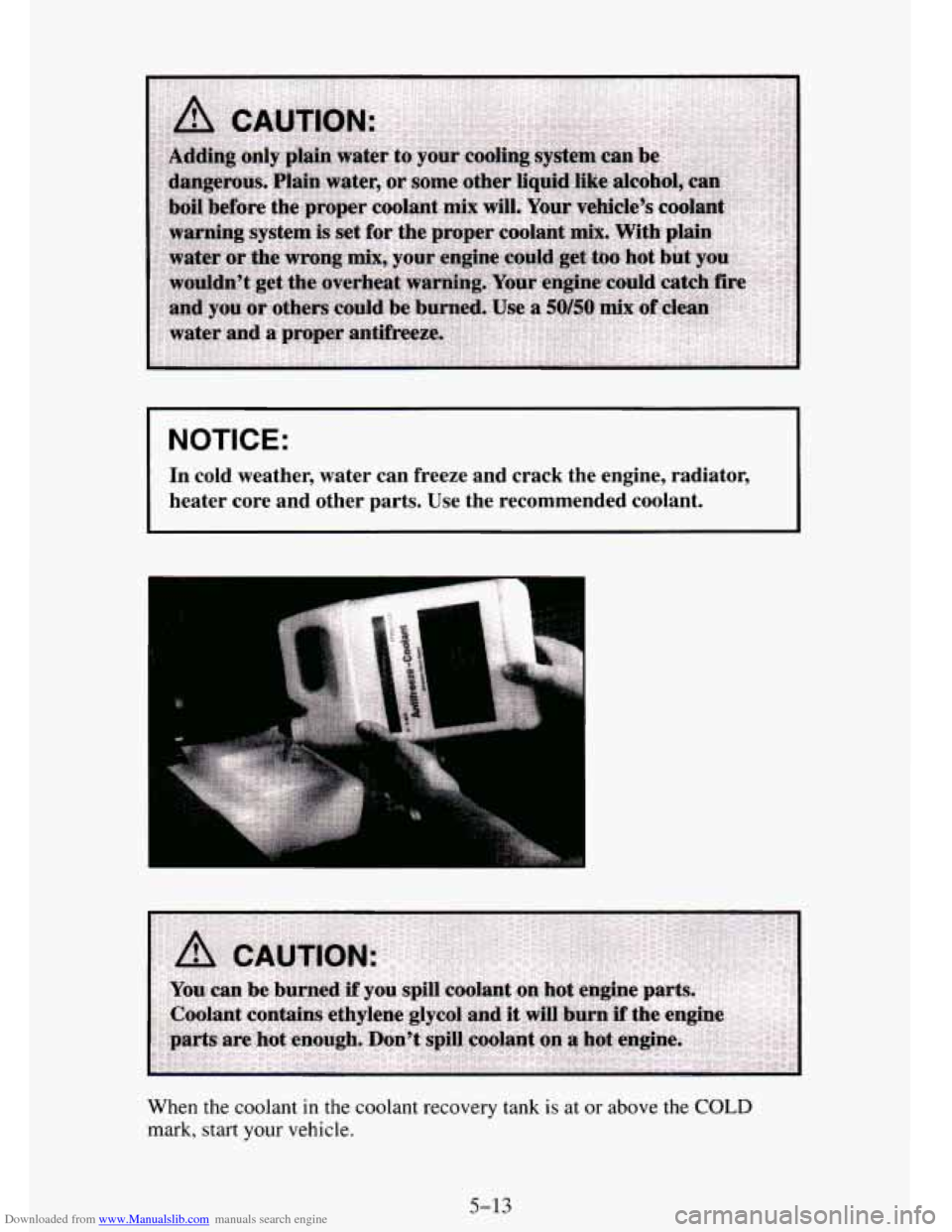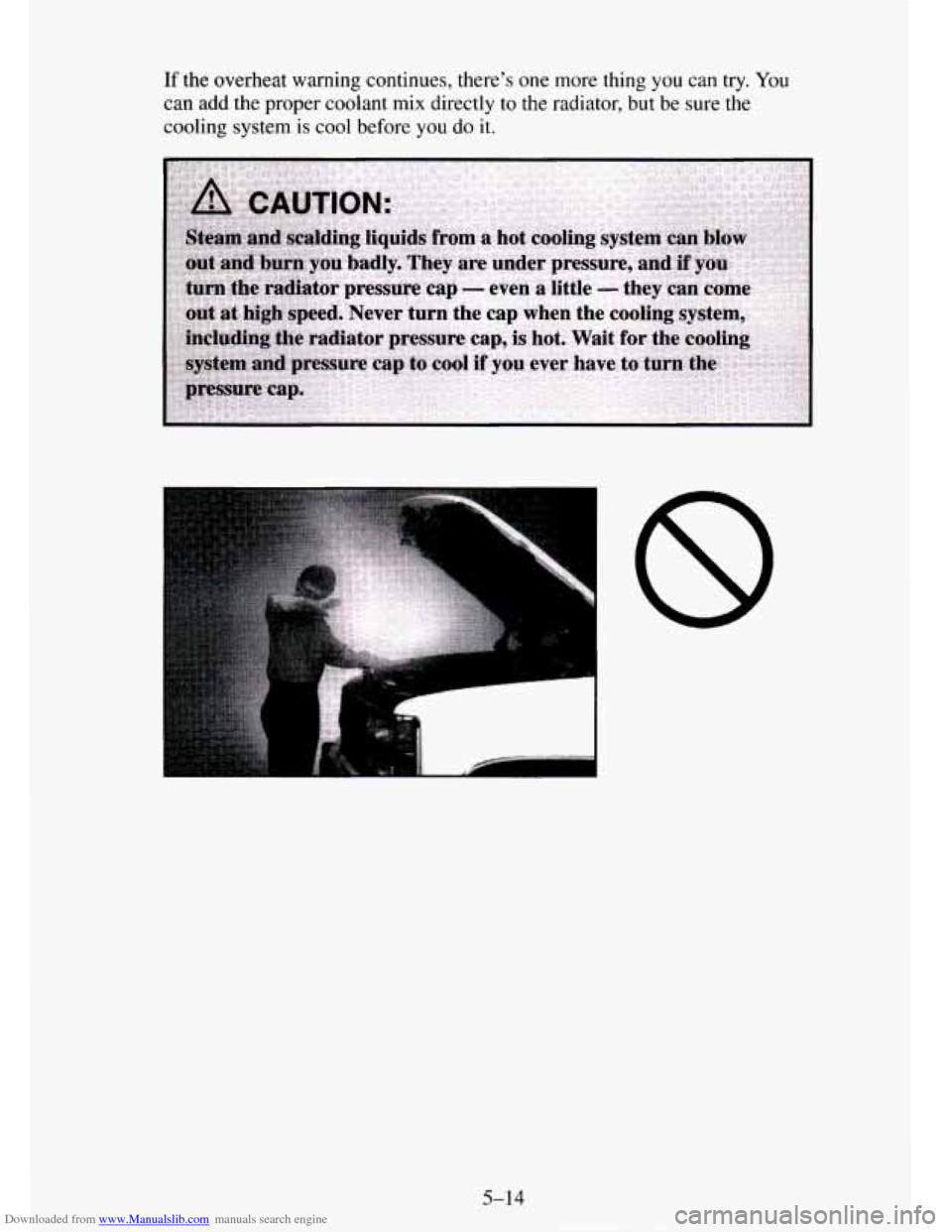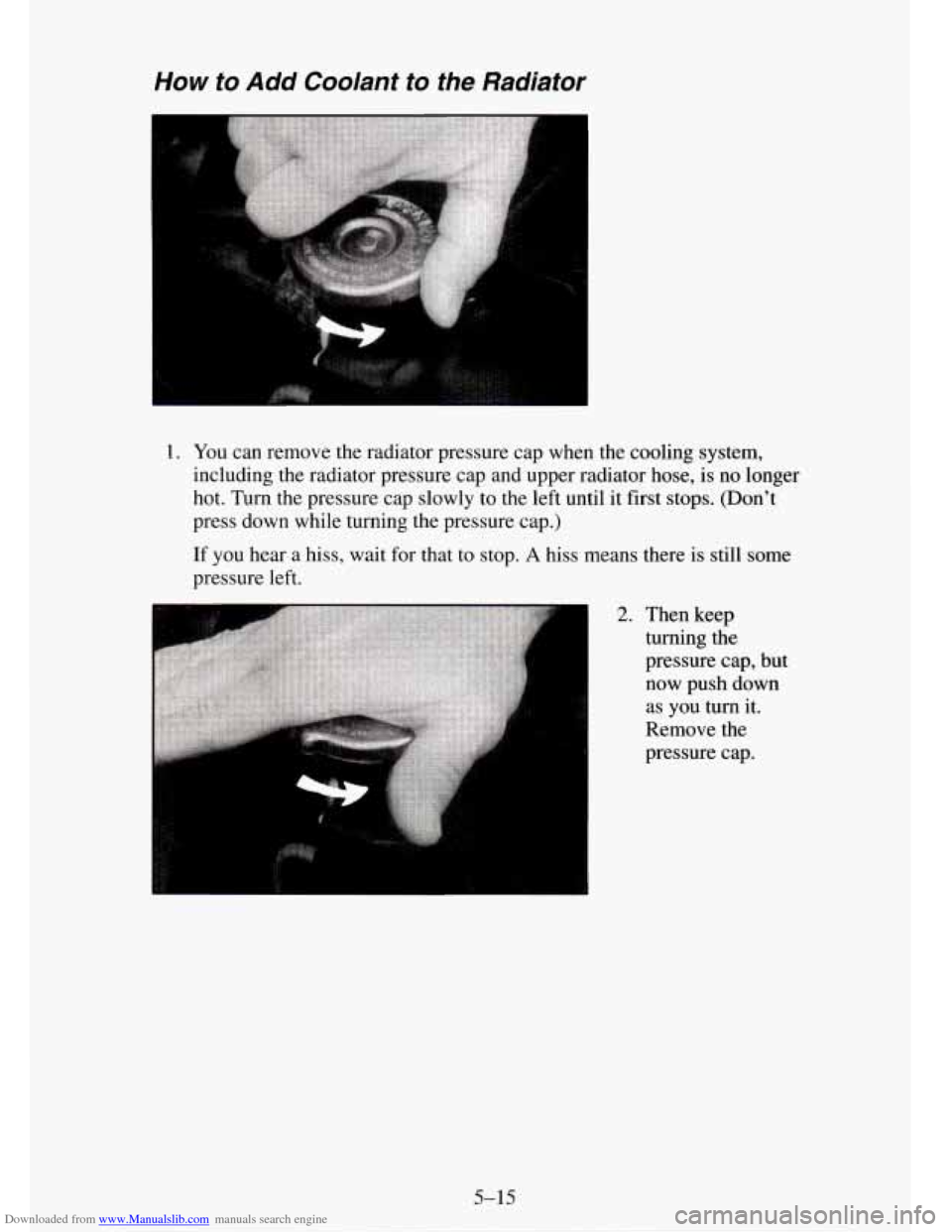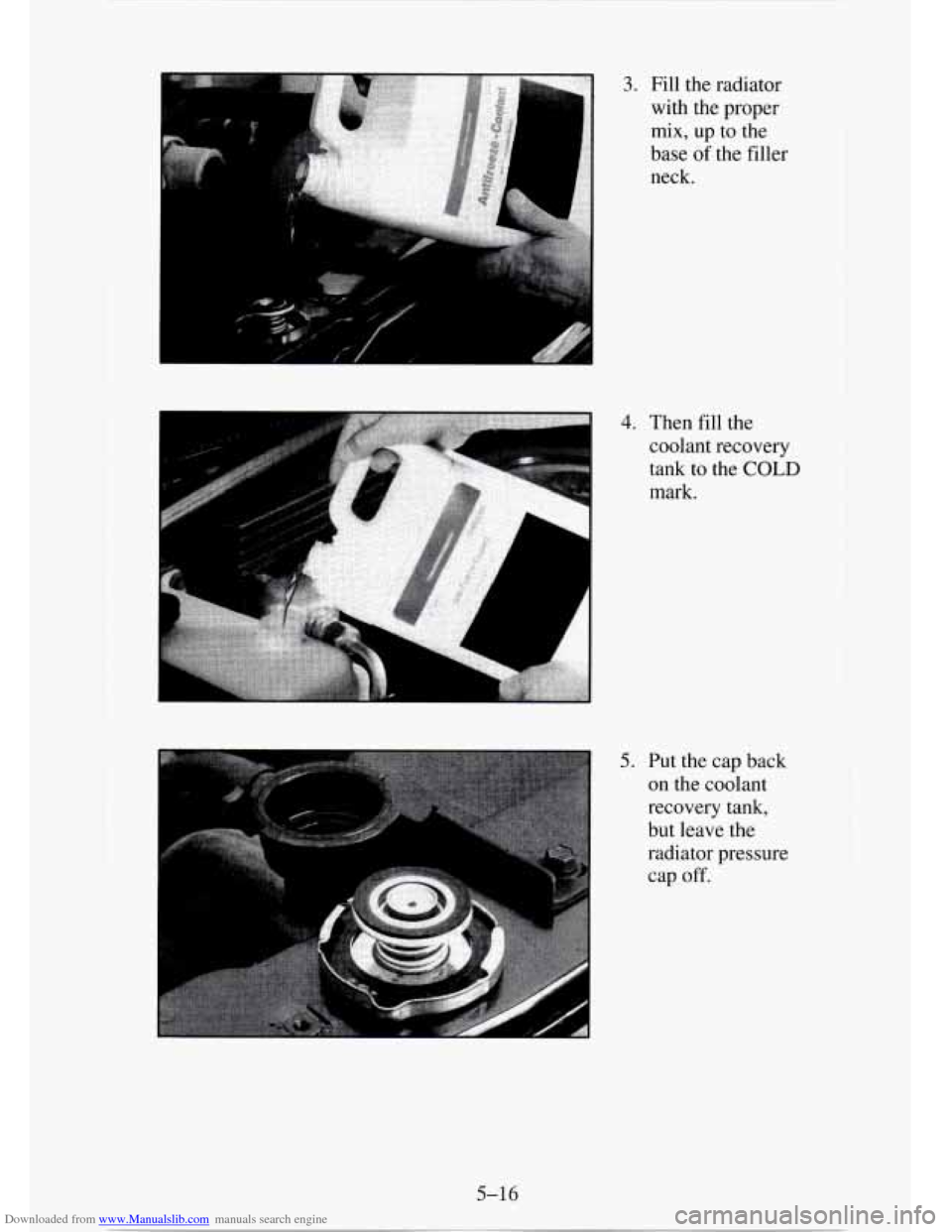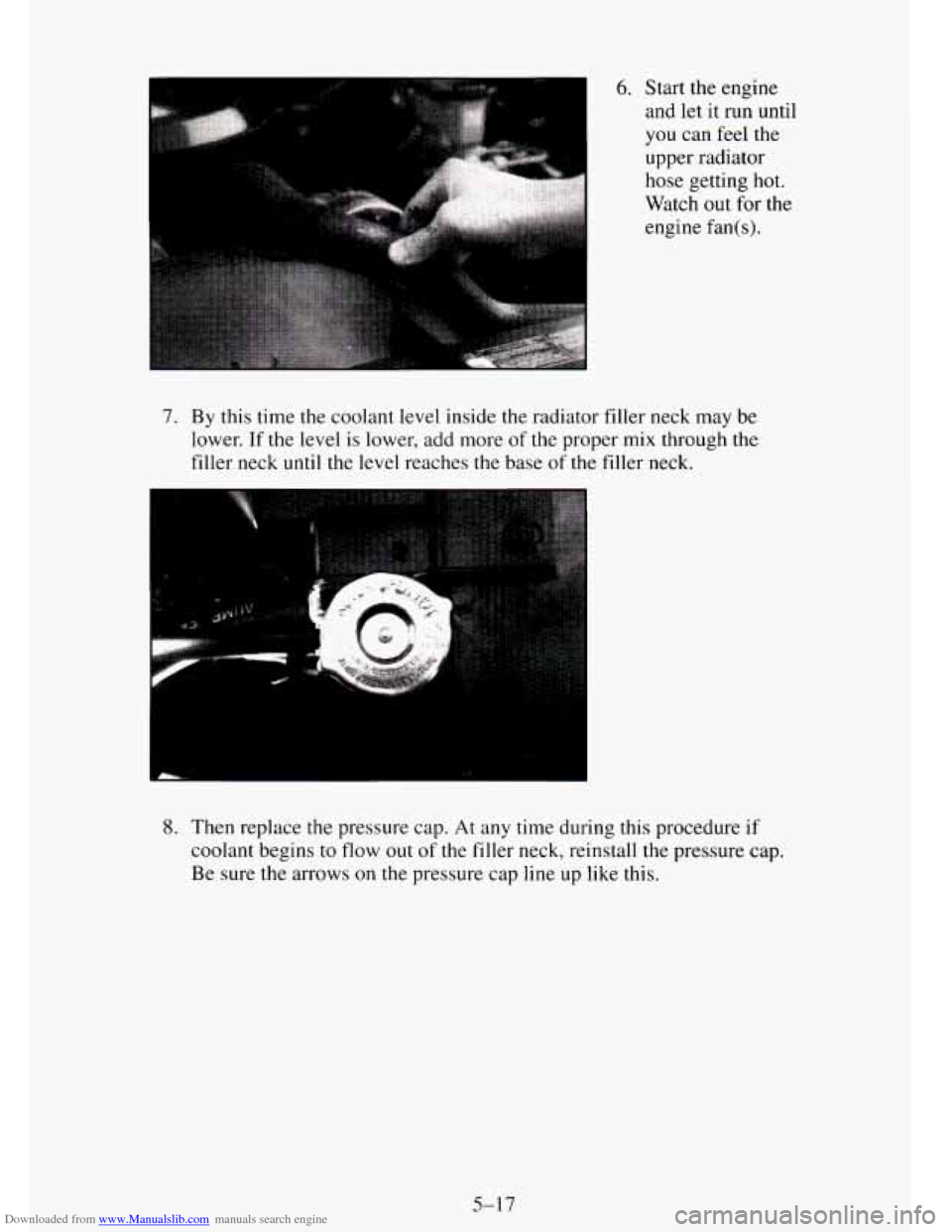CHEVROLET TAHOE 1995 1.G Owners Manual
TAHOE 1995 1.G
CHEVROLET
CHEVROLET
https://www.carmanualsonline.info/img/24/8323/w960_8323-0.png
CHEVROLET TAHOE 1995 1.G Owners Manual
Trending: oil temperature, low beam, clock setting, lumbar support, ECO mode, jacking points, lock
Page 241 of 486
Downloaded from www.Manualslib.com manuals search engine Towing From the Front
If you have a two-wheel drive vehicle, don’t have your vehicle towed on
the rear wheels, unless you must. If the vehicle must be towed
on the rear
wheels, don’t go more than
35 mph (56 km/h) or farther than 50 miles (80
km) or your transmission will be damaged. If these limits must be exceeded,
then
the rear wheels have to be supported on a dolly.
If your vehicle has the four-wheel drive option and the transfer case is
engaged, a dolly must be used under the rear wheels when towing from the
front.
5-8
.
Page 242 of 486
Downloaded from www.Manualslib.com manuals search engine Towing From the Rear
Engine Overheating
If Steam Is Coming From Your Engine
5-9
Page 243 of 486
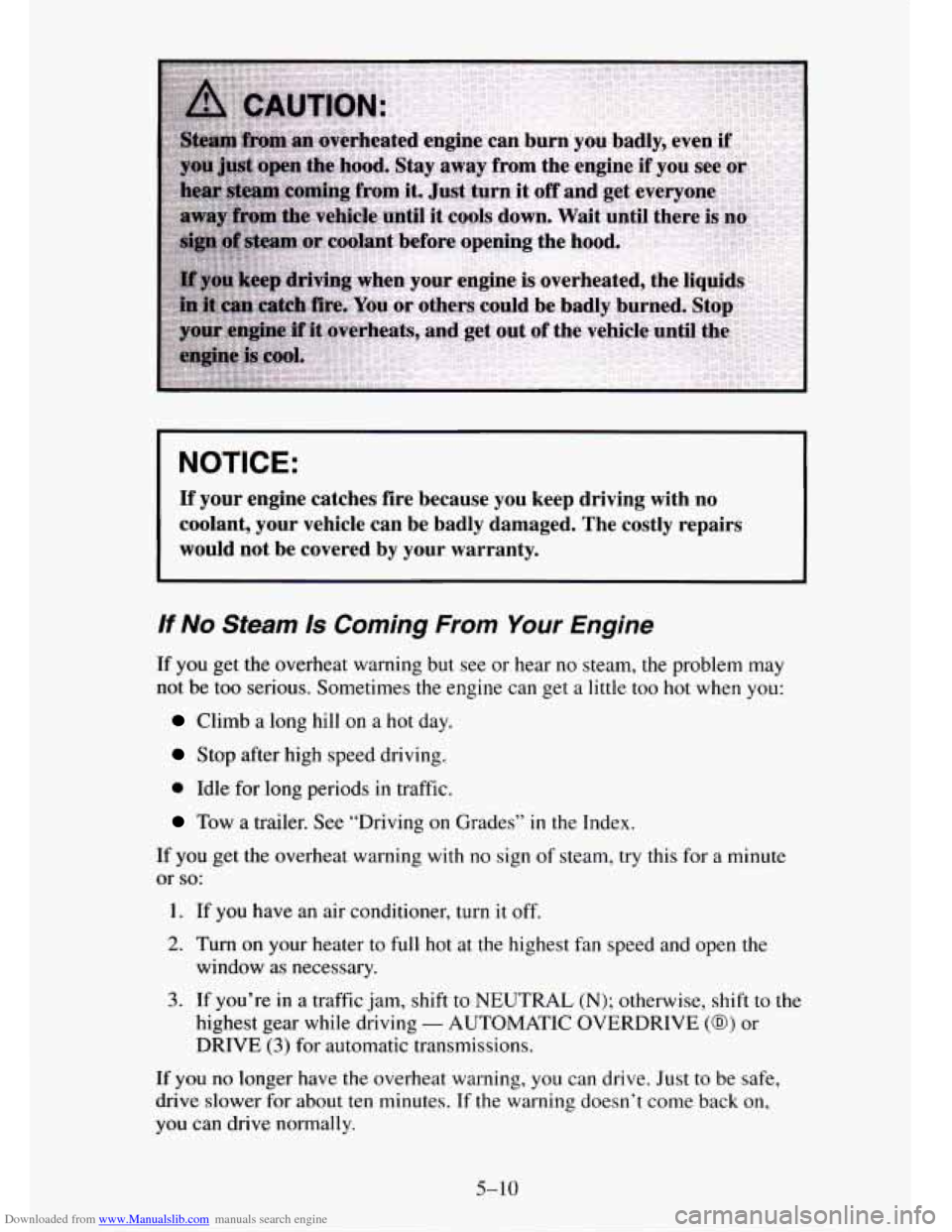
Downloaded from www.Manualslib.com manuals search engine NOTICE:
If your engine catches fire because you keep driving with no
coolant, your vehicle can be badly damaged. The costly repairs
would not be covered by your warranty.
If No Steam Is Coming From Your Engine
If you get the overheat warning but see or hear no steam, the problem may
not be too serious. Sometimes the engine can get a little too hot when you:
Climb a long hill on a hot day.
Stop after high speed driving.
0 Idle for long periods in traffic.
Tow a trailer. See “Driving on Grades” in the Index.
If you get the overheat warning with
no sign of steam, try this for a minute
or
so:
I. If you have an air conditioner, turn it off.
2. Turn on your heater to full hot at the highest fan speed and open the
window as necessary.
3. If you’re in a traffic jam, shift to NEUTRAL (N); otherwise, shift to the
highest gear while driving
- AUTOMATIC OVERDRIVE (a) or
DRIVE (3) for automatic transmissions.
If you no longer have the overheat warning, you can drive. Just to be safe,
drive slower for about ten minutes. If the warning doesn’t come back on,
you can drive normally.
5-10
Page 244 of 486
Downloaded from www.Manualslib.com manuals search engine If the warning continues, pull over, stop, and park your vehicle right away.
If there’s still no sign of steam, push the accelerator until the engine speed is
about twice as fast as normal idle speed. Bring the engine speed back
to
normal idle speed after two or three minutes. Now see if the warning stops.
But then, if you still have the warning,
turn ofthe engine and get everyone
out
of the vehicle until it cools down.
You may decide not to lift the hood but to get service help right away.
Cooling System - Gasoline Engines
When you decide it’s safe to lift the hood, here’s what you’ll see:
A. Coolant recovery tank
B . Engine fan( s)
C. Radiator pressure cap
If the coolant inside the coolant recovery tank is boiling, don’t do anything
else until
it cools down.
5-1 1
Page 245 of 486
Downloaded from www.Manualslib.com manuals search engine The coolant level
should be
at or above
the
COLD mark. If it
isn’t, you may have a
leak in the radiator
hoses, heater hoses,
radiator, water pump
or somewhere else in
the cooling system.
NOTICE:
Engine damage from running your engine without coolant isn’t \
covered
by your warranty.
If there seems to be no leak, start the engine again. See if the fan speed
increases when idle speed
is doubled by pushing the accelerator pedal down.
If it doesn’t, your vehicle needs service. Turn
off the engine.
How to Add Coolant to the Coolant Recovery Tank
If you haven’t found a problem yet, but the coolant level isn’t at or above
the
COLD mark, add a 50/50 mixture of clean water (preferably distilled)
and a proper antifreeze at the coolant recovery tank. (See “Engine Coolant”
in the Index for more information about the proper coolant mix.)
Page 246 of 486
Downloaded from www.Manualslib.com manuals search engine NOTICE:
In cold weather, water can freeze and crack the engine, radiat\
or.
heater core and other parts. Use the recommended coolant.
E
When the coolant in the coolant recovery tank is at or above the COLD
mark, start your vehicle.
5-13
Page 247 of 486
Downloaded from www.Manualslib.com manuals search engine If the overheat warning continues, there's one more thing you can try. You
can
add the proper coolant mix directly to the radiator, but be sure the
cooling system is
cool before you do it.
Page 248 of 486
Downloaded from www.Manualslib.com manuals search engine How to Add Coolant to the Radiator
1. You can remove the radiator pressure cap when the cooling system,
including the radiator pressure cap and upper radiator hose,
is no longer
hot. Turn the pressure cap slowly to the left until
it first stops. (Don’t
press down while turning the pressure cap.)
If you hear a hiss, wait for that to stop.
A hiss means there is still some
pressure left.
2. Then keep turning the
pressure cap, but
now push down
as you turn it.
Remove the
pressure cap.
5-15
Page 249 of 486
Downloaded from www.Manualslib.com manuals search engine 3. Fill the radiator with the proper
mix, up to the
base
of the filler
neck.
4. Then fill the
coolant recovery
tank to the
COLD
mark.
5. Put the cap back
on the coolant
recovery tank,
but leave the
radiator pressure
cap
off.
5-1 6
Page 250 of 486
Downloaded from www.Manualslib.com manuals search engine I
6. Start the engine
and let it run until
you can feel the
upper radiator
hose getting hot.
Watch
out for the
engine fan(s).
7. By this time the coolant level inside the radiator filler neck may be
lower. If the level
is lower, add more of the proper mix through the
filler neck until the level reaches the base of the filler neck.
8. Then replace the pressure cap. At any time during this procedure if
coolant begins to flow out of the filler neck, reinstall the pressure cap.
Be sure the arrows
on the pressure cap line up like this.
5-1 7
Trending: coolant temperature, reset, brake pads, check transmission fluid, maintenance schedule, oil, fuse box
